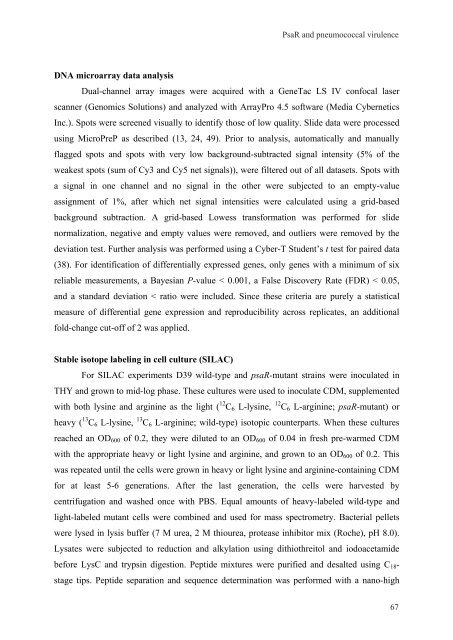Gene regulation in Streptococcus pneumoniae - RePub - Erasmus ...
Gene regulation in Streptococcus pneumoniae - RePub - Erasmus ...
Gene regulation in Streptococcus pneumoniae - RePub - Erasmus ...
Create successful ePaper yourself
Turn your PDF publications into a flip-book with our unique Google optimized e-Paper software.
DNA microarray data analysis<br />
Dual-channel array images were acquired with a <strong>Gene</strong>Tac LS IV confocal laser<br />
scanner (Genomics Solutions) and analyzed with ArrayPro 4.5 software (Media Cybernetics<br />
Inc.). Spots were screened visually to identify those of low quality. Slide data were processed<br />
us<strong>in</strong>g MicroPreP as described (13, 24, 49). Prior to analysis, automatically and manually<br />
flagged spots and spots with very low background-subtracted signal <strong>in</strong>tensity (5% of the<br />
weakest spots (sum of Cy3 and Cy5 net signals)), were filtered out of all datasets. Spots with<br />
a signal <strong>in</strong> one channel and no signal <strong>in</strong> the other were subjected to an empty-value<br />
assignment of 1%, after which net signal <strong>in</strong>tensities were calculated us<strong>in</strong>g a grid-based<br />
background subtraction. A grid-based Lowess transformation was performed for slide<br />
normalization, negative and empty values were removed, and outliers were removed by the<br />
deviation test. Further analysis was performed us<strong>in</strong>g a Cyber-T Student’s t test for paired data<br />
(38). For identification of differentially expressed genes, only genes with a m<strong>in</strong>imum of six<br />
reliable measurements, a Bayesian P-value < 0.001, a False Discovery Rate (FDR) < 0.05,<br />
and a standard deviation < ratio were <strong>in</strong>cluded. S<strong>in</strong>ce these criteria are purely a statistical<br />
measure of differential gene expression and reproducibility across replicates, an additional<br />
fold-change cut-off of 2 was applied.<br />
PsaR and pneumococcal virulence<br />
Stable isotope label<strong>in</strong>g <strong>in</strong> cell culture (SILAC)<br />
For SILAC experiments D39 wild-type and psaR-mutant stra<strong>in</strong>s were <strong>in</strong>oculated <strong>in</strong><br />
THY and grown to mid-log phase. These cultures were used to <strong>in</strong>oculate CDM, supplemented<br />
with both lys<strong>in</strong>e and arg<strong>in</strong><strong>in</strong>e as the light ( 12 C6 L-lys<strong>in</strong>e, 12 C6 L-arg<strong>in</strong><strong>in</strong>e; psaR-mutant) or<br />
heavy ( 13 C6 L-lys<strong>in</strong>e, 13 C6 L-arg<strong>in</strong><strong>in</strong>e; wild-type) isotopic counterparts. When these cultures<br />
reached an OD600 of 0.2, they were diluted to an OD600 of 0.04 <strong>in</strong> fresh pre-warmed CDM<br />
with the appropriate heavy or light lys<strong>in</strong>e and arg<strong>in</strong><strong>in</strong>e, and grown to an OD600 of 0.2. This<br />
was repeated until the cells were grown <strong>in</strong> heavy or light lys<strong>in</strong>e and arg<strong>in</strong><strong>in</strong>e-conta<strong>in</strong><strong>in</strong>g CDM<br />
for at least 5-6 generations. After the last generation, the cells were harvested by<br />
centrifugation and washed once with PBS. Equal amounts of heavy-labeled wild-type and<br />
light-labeled mutant cells were comb<strong>in</strong>ed and used for mass spectrometry. Bacterial pellets<br />
were lysed <strong>in</strong> lysis buffer (7 M urea, 2 M thiourea, protease <strong>in</strong>hibitor mix (Roche), pH 8.0).<br />
Lysates were subjected to reduction and alkylation us<strong>in</strong>g dithiothreitol and iodoacetamide<br />
before LysC and tryps<strong>in</strong> digestion. Peptide mixtures were purified and desalted us<strong>in</strong>g C18stage<br />
tips. Peptide separation and sequence determ<strong>in</strong>ation was performed with a nano-high<br />
67<br />
67

















